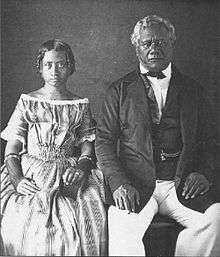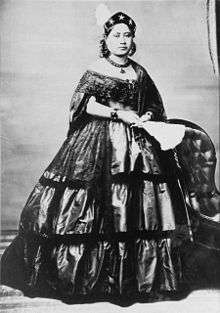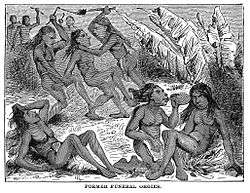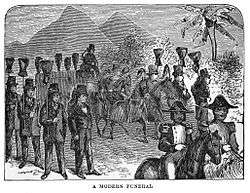Victoria Kamāmalu
| Victoria Kamāmalu | |||||
|---|---|---|---|---|---|
| Crown Princess of the Hawaiian Islands and Kuhina Nui of the Hawaiian Islands | |||||
 | |||||
| Kuhina Nui of the Hawaiian Islands | |||||
| Reign | January 16, 1855 – December 21, 1863 | ||||
| Predecessor | Keoni Ana | ||||
| Successor | Kekūanāoʻa | ||||
| Born |
November 1, 1838 Honolulu Fort, Honolulu, Oʻahu | ||||
| Died |
May 29, 1866 (aged 27) Papakanene, Honolulu, Oʻahu | ||||
| Burial |
June 30, 1866[1][2] Mauna Ala Royal Mausoleum | ||||
| |||||
| House | House of Kamehameha | ||||
| Father | Kekūanāoʻa | ||||
| Mother | Kīnaʻu | ||||
| Signature |
| ||||
Victoria Kamāmalu Kaʻahumanu IV (1838–1866), was Kuhina Nui of Hawaii and its crown princess. Named Wikolia Kamehamalu Keawenui Kaʻahumanu-a-Kekūanaōʻa[3] and also named Kalehelani Kiheahealani,[3] she was mainly referred to as Victoria Kamāmalu or Kaʻahumanu IV,[4] when addressing her as the Kuhina Nui.
Family
Born at the Honolulu Fort, on November 1, 1838, she was the only daughter of Elizabeth Kīnaʻu, Kaʻahumanu II and her third husband Mataio Kekūanāoʻa. Through her mother she was granddaughter of King Kamehameha I, founder of the kingdom. Her two brothers would later become kings of Hawaii as Kamehameha IV and Kamehameha V. She was named after her maternal aunt Queen Kamāmalu, the consort of Kamehameha II, who died in London from the measles. The Christian name Victoria was after Queen Victoria and signified the close friendship of the British monarchs and the Hawaiian monarchs.[5][6] Having given away her previous four sons, Kaʻahumanu II refused to give her only remaining daughter in hānai to John Adams Kuakini who wanted to take her to raise on the Big Island. She defied customs of the time and personally nursed her daughter.[7] Her mother died not long after her birth. She would become the highest female chief in Hawaii at the time. Her kahu (attendants) were John Papa ʻĪʻī and his wife Sarai. They later followed Victoria to school due to her age at the time.[5]:161[8]
Early life

She was educated at Royal School along with all her cousins and brothers. She was expected from birth to one day succeed to the position of Kuhina Nui if not the office of monarch, so she was educated by the Cooke with full attention to what political scheme she would play in the near future. In the school, they were permitted to visit with relatives from time to time. When the students fell ill, their kahu and families went to the school and stayed for a while to attend to the patient. Victoria's kahu, John Papa ʻĪʻī, eventually was appointed kahu for all the students at the Chief's Children's School and visited in that capacity, though his political services were in such demand by the court that he was often absent.
Her father Kekūanāoʻa raised her. He was the royal governor of Oahu. In Honolulu her father built her a Greek-revival mansion which was the largest house in the town of Honolulu, or anywhere in Hawaii, at the time. Her father was in debt to the foreigners, so Kamehameha III bought the palace from him. He made it his royal palace and call it Hale Aliʻi (House of the Chiefs) and this was the first ʻIolani Palace.
She was two months younger than the future queen Liliʻuokalani. They were close friends and foster-siblings. At her birth, the High Chiefess Laura Kōnia went to Kina`u with her adoptive daughter Liliʻu. Kinau would nurse Liliʻu while handing her own daughter to a nurse. According to Liliʻuokalani, both girls would share everything from a young age and when Victoria visit her aunt Kekāuluohi, Liliʻuokalani would be invited too. Victoria was destined from a young age to become a sovereign like her siblings, but it would be Liliʻuokalani who would later become the first Queen of Hawaii due to Victoria's own death.[9]
Kuhina Nui

It was intended that she would succeed her mother Kīnaʻu in the position of Kuhina Nui, but her mother died while she was still a minor. Her aunt Kekāuluohi became a place-holder for her niece using the name Kaʻahumanu III, but she died when her niece was seven, so her uncle Kamehameha III appointed John Kalaipaihala Young II, also known as Keoni Ana, the son of John Young as Kuhina Nui. Princess Kamāmalu was appointed as Heiress Presumptive to the title of Kuhina-Nui in 1850, successor to Keoni Ana. Since 1845, by legislative act, the office of Kuhina Nui had been joined with that of the Minister of Interior. Given her young age, it would have been clear to the King, Privy Council, and Legislative Council that Victoria was not suited to be Minister of Interior. Therefore, on January 6, 1855, an act was passed to repeal the earlier legislation.[10]
In 1854, her uncle died and her brother succeeded as King of Hawaii. According to Robert Crichton Wyllie, the Minister of Foreign Affairs and a trusted friend of the royal family, opponents of the new king were planning to overthrow him and place his sister Princess Victoria on the throne instead. However, the conspiracy never culminated into anything.[11] She became Kuhina Nui in 1855 mainly due to her brother, Kamehameha IV's, ascension to the throne and the death of her uncle. It is probable that Kamehameha III had meant for Keoni Ana to hold the office till his death. She presided over the King’s Privy Council. She constitutionally assumed the power of state for a day when her brother Kamehameha IV died leaving no designated heirs in 1864. Section II Article 47 of the 1852 Constitution of the Hawaiian Kingdom provided that the Kuhina Nui (Premier), in absence of a monarch, would fill the vacant office.
Whenever the throne shall become vacant by reason of the King¹s death, or otherwise, and during the minority of any heir to the throne, the Kuhina Nui, for the time being, shall, during such vacancy or minority, perform all the duties incumbent on the King, and shall have and exercise all the powers, which by this Constitution are vested in the King.
After consulting with the Privy Councilors, she proclaimed in front the Legislature:
It having pleased Almighty God to close the earthly career of King Kamehameha IV, at a quarter past 9 o'clock this morning, I, as Kuhina Nui, by and with the advice of the Privy Council of State hereby proclaim Prince Lot Kamehameha, King of Hawaii, under the style and title of Kamehameha V. God preserve the King![12]

Betrothal
She was betrothed to William Charles Lunalilo. Their parents had planned out their marriage from infancy and it was popular among the Hawaiians. The date was set, but interference from her brothers cancelled the wedding.[13][14] They were forbidden to marry by her brothers Kamehameha IV and Kamehameha V. The reason was because their children would have a higher rank or mana than their own lines. Her brother, Kamehameha IV, had tried to split them apart by engaging Victoria to David Kalākaua, and Lunalilo to Lydia Kamakaʻeha.[15]
Scandal
In 1857, a scandal involved her and Marcus Cummins Monsarrat (1828–1870), a married English auctioneer. Monsarrat had been a friend to her two brothers and was a frequent dinner guest. One night, Prince Lot was informed that Monsarrat was in the Princess' bedroom. He immediately went to her room and caught him the act of "arranging his pantaloons". The enraged Prince told him to leave or he would kill him. When Kamehameha IV found out about the incident, he blamed Lot for not "shooting Monsarrat down like a dog."[16]:79 As Kuhina Nui she had to sign the papers that would banish him from Hawaiʻi:
Whereas, Marcus C. Monsarrat, a naturalized subject of this Kingdom, is guilty of having perpetuated a grievous injury to Ourselves and to Our Royal family, And Whereas, such injury is of such a character as in Our judgement, to authorize and require the expulsion of the said M. C. Monsarrat from Our Dominions...Now, therefore, know that We, in the exercise of the Power vested in Us by virtue of Our office as Sovereign of this Kingdom...do hereby order that the said Marcus C. Monsarrat be forthwith expelled from this Kingdom; and he is hereby strictly prohibited forever, from returning to any part of Our Dominions, under penalty of Death.
Later when Monsarrat returned, the King had him imprisoned and exiled again. Often accounted as Princess Kamāmalu's misbehavior and a love affair between the two, the contemporaneous Charles de Varigny defended the princess by saying Monsarrat "had acted so boldly that she called for help".[17]:86 Her brother attempted to marry her to Kalākaua.[14] For the last few years of her life, she was rarely seen in public.[18] She remained a spinster for the remaining part of her life.[14]
Crown Princess

She was an expected heir to the throne throughout her life because both her brothers were unable to leave surviving issues of their own. Princess Victoria was appointed as Heiress-Apparent and crown princess by her brother king Kamehameha V in 1863. She would have become queen of Hawaii upon her brother's death, but she predeceased him.
Considered pro-American, the princess had a close friendship with the American missionaries. Musically gifted, she was an accomplished pianist and vocalist, and she sat at the melodeon and led the choir of Kawaiahao Church for many years. The Minister of Foreign Affairs, Robert Crichton Wyllie, considered it improper that a royal princess would sing in a choir and tried convincing her to stop, but she stayed loyal to the American missionaries at Kawaiahao. When the royal family switched from the Congregational Calvinist faith to the Reformed Catholic Church or Anglican Church of Hawaii, Victoria refused to abandon her previous faith.[19]
In 1863, she founded the Kaʻahumanu Society, officially establishing it in 1864, an organization concerned with the welfare of the ill and elderly Hawaiians, originally to nurse the victims of the smallpox epidemic.[16]:188[20]
Death and legacy
She became ill during a party given at the Bishop's residence in Haleākala, Honolulu, in February 1866. The illness continued and resulted in paralysis in early May.[20] Kamāmalu did not recover and died on May 29, 1866, at the age of 27.[14][18] ʻĪʻī recorded her death in his journal:
Kamāmalu died at 10 a.m. on May 29, 1866, at Papakanene house at Mokuʻaikaua...She was in bed for three weeks before she was taken. On Sunday evenings the members of her two churches pleaded with the Lord, but the trouble was too grave for their petitions. The doctors, too, were unable to make her well. The length of her life was 27 years and seven months.[14]
Her childless death left her brother the king without obvious heirs. The Legislature had to raise $6,000 for her funeral expenses including a coffin made from fine kou and koa wood.[19]


Her funeral ceremony also revived many funeral rites of the Native Hawaiians including the kanikau (grief wailing) and public hula performances.[21] The wailing lasted for weeks. Many loyal Hawaiians walked as much as 50 miles to pay their last respects to their princess. Writing in high revolutionary fervor of the days immediately following the overthrow of the Kingdom of Hawaii, Professor William DeWitt Alexander remarked:
It is true that the germs of many evils of Kalakaua's reign may be traced to the reign of Kamehameha V. The reactionary policy of that monarch is well known. Under him the "recrudescence" of heathenism commenced, as evidenced by the Pagan orgies at the funeral of his sister. Victoria Kamāmalu, in June, 1866, and his encouragement of lascivious hula hula dancers and the pernicious class of Kahunas or sorcerers. Closely connected with this reaction was a growing jealousy and hatred of foreigners.[22]
Mark Twain, a spectator to the events, labeled the acts of the grieving Hawaiians as "pagan orgies." Twain had his letters to his newspaper in Sacramento and later he published his observations in his book Roughing It. He didn't understand that for the last years of the Princess' life, she had become disillusioned with Western modernization and retreated to the ancient Hawaiian traditions, and the funeral ceremonies were her brother's way of honoring her dying wishes.[22]
Her brother, a bachelor throughout his life, had intended that she should be his heir. Her death left her brother without an obvious successor. After his brother's death an election was held between Kalākaua and Lunalilo, both former suitors of the princess. Lunalilo easily won the election, yet his reign lasted less than a year.
She died without a written will, so her vast landholdings, including much of the original private lands of her mother and Queen Kaʻahumanu, were inherited by her father and eventually passed to her half-sister Keelikōlani who willed them to Bernice Pauahi Bishop and where they became part of the Kamehameha Schools. The Kaʻahumanu Society went on the wayside after her death, but in 1905, Lucy Peabody reorganized the club, and it continues to this day.
Honours
-
 Dame Grand Cross of the Most Noble Order of Kamehameha I.
Dame Grand Cross of the Most Noble Order of Kamehameha I.
References
- ↑ Rose, Roger G.; Conant, Sheila; Kjellgren, Eric P. (September 1993). "Hawaiian Standing Kāhili in the Bishop Museum: An Ethnological and Biological Analysis". Journal of the Polynesian Society. Wellington, NZ: Polynesian Society. 102 (3): 273–304.
- ↑ David W. Forbes, ed. (2001). Hawaiian national bibliography, 1780–1900. 3. University of Hawaii Press. p. 426. ISBN 0-8248-2503-9.
- 1 2 "United States: Hawaii: Heads of State: 1810-1898 - Archontology.org". Archontology.org. Retrieved December 2, 2014.
- ↑ Kirch, Patrick V. Sahlins, Marshall D. (1992). Anahulu: The Anthropology of History in the Kingdom of Hawaii, Volume 1: Historical Ethnography. University of Chicago Press. ISBN 0-226-73365-3.
- 1 2 Ii, John Papa; Pukui, Mary Kawena; Barrère, Dorothy B. (1983). Fragments of Hawaiian History (2 ed.). Honolulu: Bishop Museum Press. ISBN 978-0-910240-31-4.
- ↑ "Royal Family of Hawaiu". The Hawaiian Gazette. Honolulu. April 1, 1874. p. 3.
- ↑ Katharine Luomala, University of Hawaii (1987). "Reality and Fantasy: The Foster Child in Hawaiian Myths and Customs". Pacific Studies. Brigham Young University Hawaii Campus. pp. 28–29.
- ↑ History of Keoua Kalanikupuapa-i-kalani-nui, Father of Hawaii By Elizabeth Kekaaniau Pratt. Page 53
- ↑ "Hawaii's Story by Hawaii's Queen.". Digital.library.upenn.edu. Retrieved December 2, 2014.
- ↑ "Victoria Kamāmalu". Hawaii State government archives web site. Retrieved October 1, 2009.
- ↑ Taylor 1929, pp. 24, 29.
- ↑ Rosalin Uphus Comeau (1996). Kamehameha V: Lot Kapuāiwa. Kamehameha Schools Press. ISBN 0-87336-039-7.
- ↑ "Alekoki". Huapala.org. Retrieved December 2, 2014.
- 1 2 3 4 5 Kīhei de Silva. "'Alekoki Revisited". Kaleinamanu Library Archives, Kamehameha Schools. Retrieved September 3, 2011.
- ↑ "Hawaii's Story by Hawaii's Queen.". Digital.library.upenn.edu. Retrieved December 2, 2014.
- 1 2 George S. Kanahele (1999). Emma: Hawaiʻi's Remarkable Queen: a Biography. University of Hawaii Press. ISBN 978-0-8248-2240-8.
- ↑ Charles Victor Crosnier de Varigny (1874). Quatorze ans aux îles Sandwich. Hachette et cie.
- 1 2 "Death of the Heir Apparent". The Pacific Commercial Advertiser. June 2, 1866. Retrieved June 2, 2014.
- 1 2 "Mark Twain in Sacramento Union - #14". Twainquotes/com. Retrieved December 2, 2014.
- 1 2 Barbara Bennett Peterson (1984). Notable Women of Hawaii. University of Hawaii Press. p. 427. ISBN 0-8248-0820-7.
- ↑ Noenoe K. Silva (2000). "Kanawai E Ho'opau I Na Hula Kuolo Hawai'i: the Political Economy of Banning the Hula". Hawaiian Journal of History. Hawaiian Historical Society. 34: 29–48.
- 1 2 "HAWAII : Monarchy In Hawaii - Part 2". Janesoceania.com. Retrieved 2 December 2014.
Bibliography
- Taylor, Albert Pierce (October 15, 1929). "Intrigues, conspiracies and accomplishments in the era of Kamehameha IV and V and Robert Crichton Wyllie". Papers of the Hawaiian Historical Society. Honolulu: Hawaiian Historical Society. 16: 16–32. hdl:10524/978.
External links
| Wikimedia Commons has media related to Victoria Kamāmalu. |
- March 27, 1855. New York Times article on her
- Victoria Kamamalu on a Stamp
- Hawai'i's Lost Princess: Princess Victoria Kamāmalu Ka'ahumanu IV
- Victoria Kamamalu "A Worthy Successor" by Julie Stewart Williams
| Preceded by Keoni Ana |
Kuhina Nui of the Hawaiian Islands January 16, 1855 – December 21, 1863 |
Succeeded by Kekūanāoʻa |